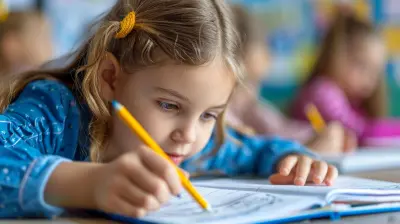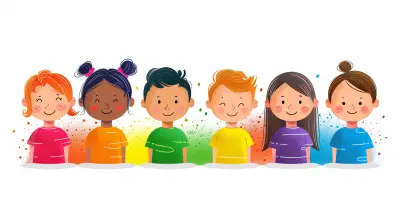21 June 2025
Imagine your toddler walking into the playroom, picking up a toy, and asking, “Why doesn’t this squeak anymore?” That’s not just curiosity—that’s the seed of critical thinking being planted right before your eyes.
Now, what if I told you that critical thinking, often thought of as a "grown-up" skill, is actually something kids can start developing from the moment they begin to explore the world around them? Yup, even preschoolers can flex those mental muscles!
In this article, we're diving deep into the importance of encouraging critical thinking in the early years. And we’ll look at how parents, caregivers, and educators can gently guide children in asking questions, solving problems, and making sense of their experiences. Ready? Let's jump in!
What Is Critical Thinking, Really?
Before we go any further, let’s break this down in simple terms.Critical thinking is the ability to think clearly, evaluate information, and make reasoned decisions. But for young kids, think of it more like a superhero skill—it helps them figure things out, spot patterns, and even come up with creative solutions when things go sideways (like when a tower of blocks keeps falling over).
It’s more than just knowing stuff—it’s how they think about what they know.
Why Should We Start Early?
You might wonder, “Do toddlers really need to think critically?” Absolutely!Just like language and social skills, critical thinking develops best when it’s nurtured early. Think of a young mind like soft clay—it’s easier to shape and mold. The earlier we introduce the idea of thinking deeply and asking questions, the stronger those skills become over time.
Kids who grow up being encouraged to wonder, explore, and question are far more likely to:
- Solve problems creatively
- Make better decisions
- Handle failure with resilience
- Communicate more effectively
- Navigate life confidently
So yes, it’s a big deal—and yes, you can start nurturing it even in preschool.
How Do Young Children Show Signs of Critical Thinking?
Seriously, kids are naturally curious. Ever heard a three-year-old ask “Why?” for the 97th time? That’s not just them being difficult. It’s their way of trying to make sense of the world around them.Even toddlers show early signs of critical thinking when they:
- Experiment with cause and effect (like dropping food on the floor just to see what happens)
- Sort objects by color or size
- Choose between two toys based on preference
- Ask endless questions about everything!
They may not be solving world problems just yet, but those tiny decisions and questions are the building blocks of bigger, more complex thought.
Creating a Thinking Environment at Home and in Class
Alright, let’s get practical. How can we encourage critical thinking without turning every moment into a classroom session?1. Ask Open-Ended Questions
Instead of yes-or-no questions, try asking:- “What do you think will happen if we mix these colors?”
- “Why do you think the leaves fall in autumn?”
- “How did you figure out how to do that?”
These kinds of questions make kids pause, reflect, and explain their thought process. And guess what? That’s the essence of critical thinking.
2. Let Them Struggle a Little
We know—it’s hard watching your child try and fail. But here’s the thing: struggle is good. It teaches resilience and activates problem-solving skills.Resist the urge to jump in every time they face a problem. Give them space to think, try, and even fail. Success isn’t just in getting it right—it’s in figuring out how to get there.
3. Encourage Play-Based Learning
Play isn’t just fun—it’s brain food!When kids engage in unstructured play, they’re often:
- Making decisions
- Working through social interactions
- Solving problems on the fly
Building with blocks, creating pretend restaurants, or inventing superhero stories all secretly strengthen critical thinking muscles.
4. Model Thinking Out Loud
Kids learn a ton just by watching and listening to us. So, talk through your own thought process:- “Hmm, I wonder how we can fix this broken zipper.”
- “I’m not sure how to water all the plants in one trip—what if we use a bigger container?”
Hearing adults think things through helps little ones realize that thinking is a process, not magic.
5. Celebrate Questions, Not Just Answers
Some kids worry about giving the wrong answer. Let’s flip the script. Instead of only praising correct responses, get excited about the questions they ask.Use phrases like:
- “That’s such an interesting question!”
- “I love how you’re thinking about this!”
- “What made you wonder that?”
Make curiosity cool.
The Role of Storytelling in Developing Critical Thinking
Stories are more powerful than we realize. Through books, kids are exposed to different characters, situations, and dilemmas. And guess what? Every story is a mini critical thinking challenge.After reading together, try asking:
- “Why do you think the character made that choice?”
- “What would you have done differently?”
- “What do you think will happen next?”
It turns storytime into a brain workout—without the sweat.
The Importance of Diverse Perspectives
Encouraging critical thinking also means teaching kids to look at things from different points of view. This helps them become more empathetic and flexible thinkers.Try activities like:
- Role-playing different characters in a story
- Talking about how others might feel in various situations
- Discussing real-life problems and imagining different solutions
The earlier kids learn that there’s more than one way to see things, the better equipped they’ll be in the future.
Making Mistakes Without Shame
Let’s be honest—no one loves making mistakes. But kids need to understand that mistakes aren’t failures; they’re stepping stones to learning.Normalize errors by saying things like:
- “Oops! I didn’t get it right the first time either.”
- “Let’s figure out what went wrong and try again.”
When kids aren’t afraid of failing, they’re more likely to take risks—and that’s when real critical thinking happens.
Technology: Friend or Foe?
Good question!When used wisely, technology can be a fantastic tool for building thinking skills. Interactive games, coding toys, and educational apps can immerse kids in puzzles, logic challenges, and creative design.
But moderation is key. We want tech to enhance thinking, not replace it.
Try co-playing with your child—ask questions, narrate your thoughts, and encourage conversation as you explore together.
Encouraging Critical Thinking Through Everyday Life
Let’s face it—life is busy. Between snacks, naps, and errands, formal learning time is limited. The good news? Everyday life is packed with opportunities to build critical thinking.Here are a few examples:
- Grocery Shopping: “Which fruit do you think is ripe? How can you tell?”
- Cooking Together: “What happens if we don’t add baking powder?”
- Getting Dressed: “It’s raining—what kind of shoes should we wear?”
Each of these everyday moments is a mini lesson in observation, prediction, and decision-making.
Partnering With Early Childhood Educators
If you're a parent, don’t underestimate the role of your child’s teachers. Educators in early childhood settings are pros at fostering a love for thinking.Get involved by:
- Asking what kinds of questions they ask in class
- Sharing what your child is curious about at home
- Reinforcing the same curiosity-driven mindset outside of school
It takes a village, right?
Long-Term Benefits of Critical Thinking in Early Childhood
Okay, so we’ve talked a lot about young kids. But let’s zoom out for a second.Kids who grow up being critical thinkers tend to:
- Learn faster and retain information better
- Adapt easily to new situations
- Communicate clearly and confidently
- Handle disagreements with grace
- Approach challenges with a can-do attitude
In other words, we’re not just helping kids do better in school—we're helping them thrive in life.
Final Thoughts
Encouraging critical thinking in the early years isn't about fancy tools or intense lessons. It’s about creating a home and classroom filled with questions, curiosity, and the freedom to explore.Remember, it’s not about having all the answers—it’s about having the confidence to ask “why,” and the courage to figure things out.
Whether you're a parent, teacher, or just someone who loves watching little minds grow, never underestimate the power of a thoughtful question, a well-timed pause, and a safe space to think out loud.
Because the world doesn’t just need more smart kids—it needs more thoughtful ones.








Verity McLemore
This article provides valuable insights into fostering critical thinking in young children. By emphasizing inquiry, exploration, and open-ended discussions, educators can create an engaging learning environment. Implementing these strategies early not only enhances cognitive skills but also nurtures curiosity and creativity, setting a strong foundation for lifelong learning. Great read!
November 17, 2025 at 12:48 PM